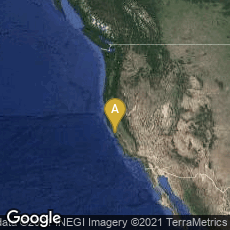

A: San Francisco, California, United States
On January 6, 2004 at the Macworld Conference & Expo in San Francisco Steve Jobs announced GarageBand.
"GarageBand is a streamlined digital audio workstation (DAW) and music sequencer that can record and play back multiple tracks of audio. Built-in audio filters that utilize the AU (audio unit) standard allow the user to enhance the audio track with various effects, including reverb, echo, and distortion amongst others. GarageBand also offers the ability to record at both 16-bit and 24-bit Audio Resolution. An included tuning system helps with pitch correction and can effectively imitate the Auto-Tune effect when tuned to the maximum level.
"Virtual software instruments
"GarageBand includes a large selection of realistic, sampled instruments and software modeled synthesizers. These can be used to create original compositions or play music live through the use of a USB MIDI keyboard connected to the computer, an on-screen virtual keyboard, or using a standard QWERTY keyboard with the "musical typing" feature. The synthesizers are broken into 2 groups: [virtual] analog and digital. Each synthesizer has a wide variety of adjustable parameters, including richness, glide, cut off, standard attack, decay, sustain, and release; these allow for a wide array of sounds to be created.
"Guitar features
In addition to the standard tracks, Garageband allows for guitar-specific tracks that can utilize a variety of simulated amplifiers, stomp boxes, and effects processors. These imitate popular hardware from companies including Marshall Amplification, Orange Music Electronic Company, and Fender Musical Instruments Corporation. Up to five simulated effects can be layered on top of the virtual amplifiers, which feature adjustable parameters including tone, reverb, and volume. Guitars can be connected to Macs using the built-in input (requires hardware that can produce a standard stereo signal using a 3.5mm output) or a USB interface.
"MIDI editing
"GarageBand can import MIDI files and offers piano roll or notation-style editing and playback. By complying with the MIDI Standard, a user can edit many different aspects of a recorded note, including pitch, velocity, and duration. Pitch can be set to 1/128 of a semi-tone, on a scale of 0-127 (sometimes described on a scale of 1-128 for clarification). Velocity, which determines amplitude (volume), can be set and adjusted on a scale of 0-127. Note duration can be adjusted manually via the piano roll or in the score view. Note rhythms can be played via the software instruments, or created in the piano roll environment; rhythm correction is also included to lock notes to any time signature subdivision. GarageBand also offers global editing capabilities to MIDI information with Enhanced Timing, also known as Quantizing. Whilst offering comprehensive control over MIDI files, GarageBand does not include several features of professional-level DAWs, such as a sequencer for drum tracks separate from the normal piano roll. However, many of these shortcomings have been addressed with each successive release of GarageBand.
Music lessons
"A new feature included with GarageBand '09 and later is the ability to download pre-recorded music lessons from GarageBand's Lesson Store for guitar and piano. There are two types of lesson available in the Lesson Store: Basic Lessons, which are a free download, and Artist Lessons, which must be purchased. The first Basic Lessons for both guitar and piano are included with GarageBand. In both types of lesson, a music teacher presents the lesson, which is in a special format offering high quality video and audio instructions. The lessons include a virtual guitar or piano, which demonstrates finger position and a musical notational area to show the correct musical notations. The music examples used in these lessons features popular music. In an Artist Lesson the music teacher is the actual musician/songwriter who composed the song being taught in the lesson. As of November 2009 the artists featured are: Sting (Roxanne, Message in a Bottle, Fragile), Sarah McLachlan (Angel), Patrick Stump of Fall Out Boy (I Don't Care, Sugar, We're Goin' Down), Norah Jones (Thinking About You), Colbie Caillat (Bubbly), Sara Bareilles (Love Song), John Fogerty (Proud Mary, Fortunate Son, Centerfield), Ryan Tedder of OneRepublic (Apologize), Ben Folds (Brick, Zak and Sara), John Legend (Ordinary People), and Alex Lifeson of Rush (Tom Sawyer, Limelight, Working Man, The Spirit of Radio). No new Artist Lessons have been released in 2010, and Apple has not announced plans to release any more" (Wikipedia article on GarageBand, accessed 08-12-2013).